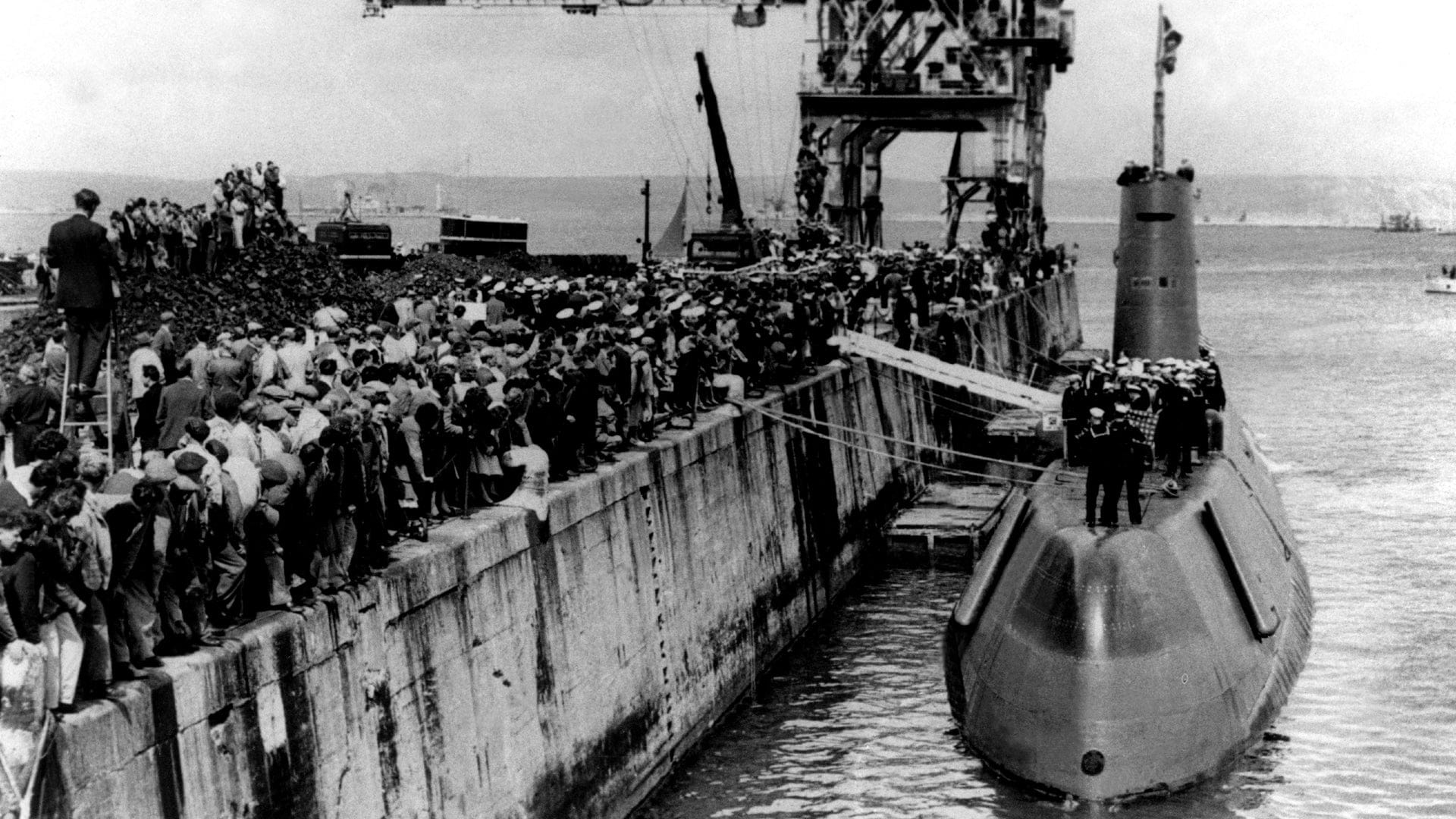Submarines aren’t just for stealthy maneuvers and deep-sea exploration. They’ve also played a pivotal role in conquering one of the world’s most formidable frontiers: reaching the North Pole from beneath the ice. From Sir Hubert Wilkins’s early endeavors to the USS Nautilus‘s historic 1958 voyage, these audacious expeditions have redefined the limits of human ingenuity and endurance, all in pursuit of knowledge and a place in history at the Earth’s summit.
Pioneering Submerged Exploration: Two Nautilus Expeditions
The North Pole, a realm of icy enigma, has always beckoned explorers. But envision venturing beneath its frozen waves, into the silent, inky depths, and surfacing at the planet’s apex—underwater! Two daring expeditions, separated by decades, embarked on this very mission. Both aboard submarines christened Nautilus, they set their sights on conquering the North Pole.
A Bold Beginning: The 1931 Nautilus Expedition
In 1931, Australian explorer Sir Hubert Wilkins embarked on a groundbreaking quest: to reach the North Pole by submarine. Driven by a thirst for knowledge and a passion for unlocking the Arctic’s secrets, Wilkins and his courageous crew set sail in the modified submarine Nautilus.
Navigating the labyrinthine Arctic Ocean, the Nautilus confronted treacherous conditions and relentless mechanical issues. Despite their valiant efforts, the crew couldn’t reach the Pole submerged. However, their expedition was far from a failure. Their unwavering spirit and the scientific data they collected blazed a trail for future explorers, demonstrating the potential of submarines to unveil the Arctic’s mysteries.
Breaking Barriers: USS Nautilus Makes History in 1958
Fast forward to 1958. The Cold War gripped the world, and the United States sought to assert its technological dominance. Enter the USS Nautilus (SSN-571), a marvel of engineering and the world’s first nuclear-powered submarine. Tasked with a top-secret mission dubbed “Operation Sunshine,” the Nautilus and its commander, William R. Anderson, were poised to make history.
Their objective was daunting: navigate treacherous Arctic ice and evade the constant threat of Soviet submarines. On August 3, 1958, the Nautilus accomplished the unimaginable, becoming the first submarine to reach the North Pole submerged beneath the ice.
The Enduring Legacy of the Nautilus Expeditions
These expeditions transcended mere historical footnotes; they revolutionized our understanding of the Arctic. They proved that submarines could be powerful tools for exploration in this extreme environment, unlocking doors to scientific discovery.
The data collected on these voyages—information about ice formations, ocean currents, and the rich biodiversity beneath the surface—proved invaluable. It deepened our understanding of the Arctic, revealing its fragility and the urgent need for its protection.
An Inspiration for Generations
The Nautilus expeditions continue to inspire today. These journeys, marked by challenges, unwavering courage, and cutting-edge technology, embody the spirit of human curiosity, reminding us that the pursuit of knowledge can lead to extraordinary discoveries, even in the most remote corners of our planet.
Was the USS Nautilus Under the North Pole?
Yes, indeed! On August 3, 1958, the USS Nautilus (SSN-571), a submarine unlike any other at the time, plunged into the icy depths and achieved a monumental feat—becoming the first vessel to reach the geographic North Pole while submerged.
This groundbreaking achievement was made possible by the Nautilus‘s revolutionary nuclear propulsion system, which allowed for sustained high speeds and extended underwater endurance compared to its diesel-electric predecessors. At the helm of this daring adventure was Captain William Anderson, leading a crew prepared to face the challenges of navigating beneath a massive ice cap using sonar and advanced inertial guidance systems.
The Nautilus‘s accomplishment transcended mere geographical triumph. During the height of the Cold War, it marked a turning point, showcasing American technological prowess on the world stage and significantly impacting the ongoing arms race.
Beyond its geopolitical implications, the Nautilus‘s journey provided invaluable scientific data about the Arctic. This data proved crucial for engineers, who used it to improve the design and construction of future submarine classes, and for scientists, who gained a better understanding of the Arctic’s fragile ecosystem and the impact of human activity on this remote region.
Today, the Nautilus enjoys a well-deserved retirement as a National Historic Landmark and museum ship in Groton, Connecticut. However, its legacy extends far beyond its physical form. The Nautilus serves as a reminder that with courage, ingenuity, and a bit of luck, humanity can push the boundaries of what’s possible and achieve the seemingly impossible.
What Happened to the Nautilus Arctic Expedition?
In 1931, a team of daring explorers, led by Sir Hubert Wilkins, embarked on an ambitious expedition aboard the modified World War I submarine Nautilus with the goal of reaching the North Pole submerged. They faced a myriad of challenges, ultimately preventing them from achieving their goal.
The Nautilus, despite modifications, was ill-equipped to handle the extreme Arctic conditions. The intense cold and unforgiving ice wreaked havoc on the submarine’s systems, causing frequent mechanical problems. As the Nautilus navigated treacherous ice floes, it sustained damage to its diving planes, essential for submerging, effectively scuttling their plans to travel beneath the ice cap to the North Pole.
Beyond mechanical difficulties, the Arctic environment itself presented formidable obstacles. Lacking advanced sonar systems and detailed maps, the crew struggled to navigate accurately beneath the ice, further hindering their progress.
While the 1931 Nautilus expedition didn’t achieve its ultimate objective, it was a significant endeavor. The expedition demonstrated the potential of submarines for Arctic exploration and provided valuable data about Arctic ice, ocean currents, and marine life. This information proved crucial for future expeditions, including the 1958 voyage of the nuclear-powered USS Nautilus, which ultimately reached the North Pole submerged.
The 1931 Nautilus expedition serves as a reminder that even in the face of setbacks, valuable lessons can be learned, paving the way for future success and expanding our understanding of our planet.
How Much Does It Cost to Go to the North Pole on an Expedition?
Dreaming of standing at the top of the world? A North Pole expedition is an incredible, once-in-a-lifetime adventure, but it comes at a cost. While prices vary depending on several factors, expect to spend between $28,000 and $40,000, and potentially significantly more for added luxuries or unique experiences.
Here’s a breakdown of the cost factors:
Expedition Type:
- Cruises: This is the most popular option, with prices starting around $28,000 for a basic cabin on a two-week journey. Luxury accommodations and extended itineraries can push the cost well over $40,000.
- Flights: For those short on time, flights offer a quicker, albeit pricier, option, often exceeding $50,000.
- Other Adventures: Thrill-seekers can opt for experiences like heli-skiing or dog-sledding expeditions, with costs varying depending on duration and included services.
Timing:
Peak season, during the summer months, typically commands higher prices due to more favorable weather conditions.
Duration:
Longer expeditions naturally cost more, allowing for more extensive exploration and potential wildlife sightings.
Cabin Choice:
As with any cruise, cabin selection significantly impacts the overall price, with suites commanding a premium over standard accommodations.
Itinerary:
Cruises focused solely on reaching the North Pole tend to be less expensive than those incorporating additional Arctic destinations like Franz Josef Land or Svalbard.
Inclusions:
Some cruises offer all-inclusive packages covering meals, drinks, and excursions, while others have a base price with additional costs for these extras.
Additional Costs: Don’t forget to factor in these expenses:
- Flights: International flights to and from your expedition departure point can add thousands of dollars to your trip.
- Pre/Post-Expedition Accommodation: Factor in costs for hotels before and after your expedition.
- Travel Insurance: Specialized Arctic travel insurance is non-negotiable, providing crucial coverage in case of emergencies.
- Specialized Gear: Renting or purchasing cold-weather gear can add to the overall expense.
- Gratuities: Tipping your guides and crew is customary.
The Bottom Line
While a North Pole expedition requires significant financial investment, for many, the opportunity to experience this extraordinary part of the world is an investment worth making. By carefully considering your options and planning accordingly, you can embark on an unforgettable Arctic adventure.
Who Is on an Expedition to the North Pole in Frankenstein?
In Mary Shelley’s Frankenstein, the expedition to the North Pole is led by the ambitious young explorer, Robert Walton. Driven by a thirst for discovery and a desire to leave his mark on the world, Walton sets sail with a crew of loyal sailors, determined to conquer the Arctic’s icy wilderness.
However, Walton is not alone in his quest. During his journey, he encounters another driven, yet deeply troubled, individual: Victor Frankenstein. A brilliant but reckless scientist, Victor carries the heavy burden of his creation—a monstrous being he brought to life.
Haunted by guilt and seeking solace in the vastness of the Arctic, Victor joins Walton’s expedition, adding another layer of complexity to the narrative. The North Pole, in this context, becomes more than just a geographical destination; it transforms into a powerful symbol of ambition, isolation, and the pursuit of the unknown.
Shelley likely used the North Pole expedition as a metaphor for the journeys of both men. Walton, consumed by his ambition, embarks on a physical journey into uncharted territory, mirroring his own internal exploration of life’s mysteries. Meanwhile, Victor, grappling with the repercussions of his actions, seeks refuge in the Arctic’s isolation, his inner turmoil mirroring the monstrous creation he desperately seeks to escape.
The Arctic setting, with its unforgiving conditions and stark beauty, serves as a powerful backdrop for exploring the complexities of human ambition, the consequences of unchecked desire, and the importance of human connection in the face of overwhelming isolation.
Discover the fascinating era of religious persecution and conflict in Europe through our in-depth article on the inquisition the crusades.
Explore the profound impact of the World Wars with our engaging the world wars never surrender fill in the blank worksheet, designed to test your knowledge.
Delve into the intricacies of the British monarchy’s history in our insightful article on the glorious revolution of 1688 demonstrated that parliament had.
- Unveiling the Enigma: Mansoureh Khojasteh Bagherzadeh’s Public Appearances & Private Life in Iran - July 18, 2025
- Unveiling the Mystery: Mansoureh Khojasteh Bagherzadeh’s Husband: A Rare Glimpse into a Private Life - July 18, 2025
- Unveiling Masoud Khamenei’s Mother: Power, Influence, and Iran’s Future - July 18, 2025
















